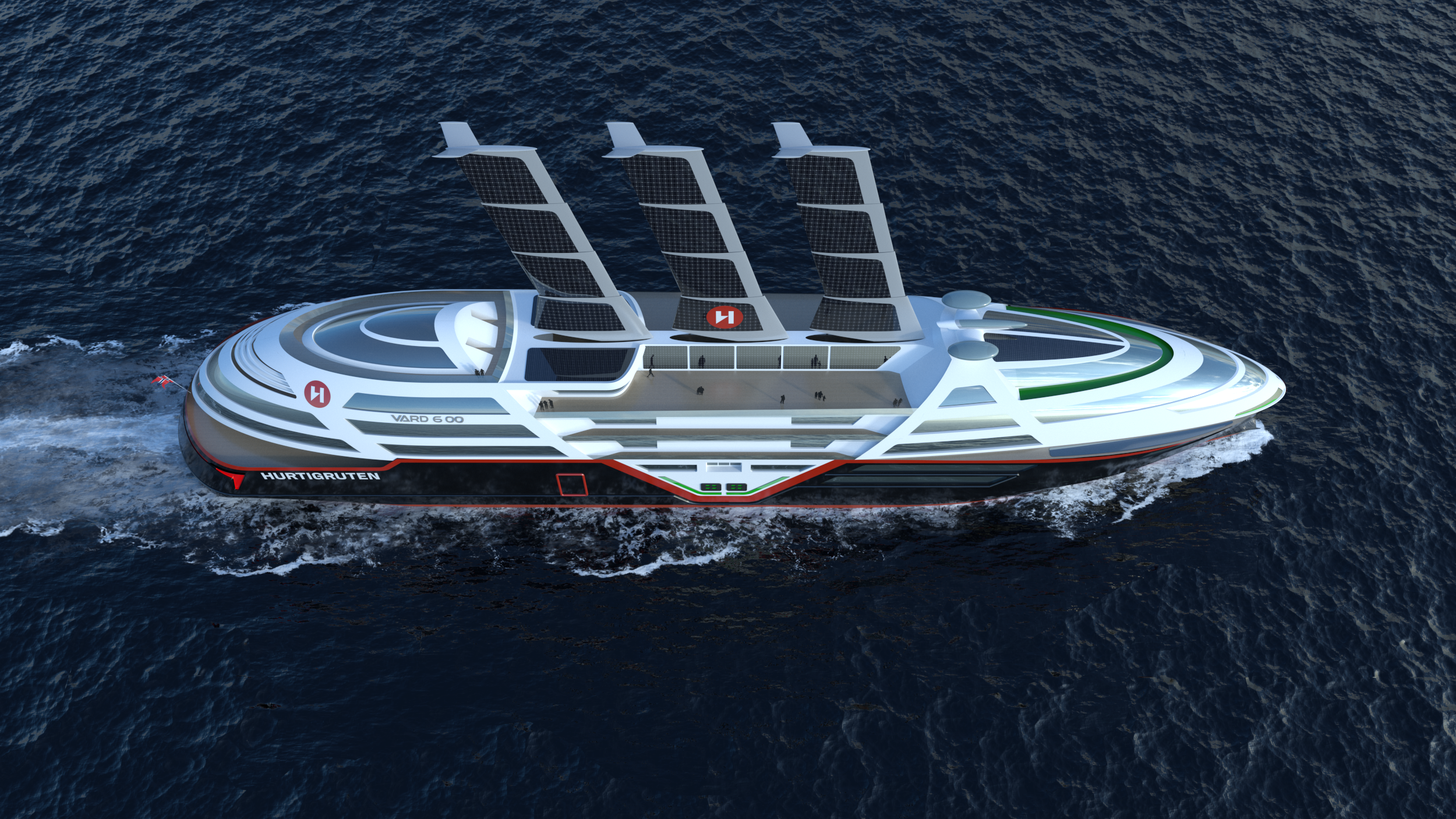 Sea Zero Concept Visualisation, sails fully extended 2. Foto: VARD Design
Sea Zero Concept Visualisation, sails fully extended 2. Foto: VARD Design
A few weeks before its 130th anniversary, Norway’s Hurtigruten has unveiled plans for its first zero-emission ship. The initiative, originally announced in March 2022 under the project name “Sea Zero”, has unveiled initial concept plans for the world’s most energy-efficient cruise ship. Hurtigruten Norway presented the results together with its consortium of 12 maritime partners and the research institute SINTEF, all working together to achieve zero-emission shipping. The consortium, which aims to develop energy-efficient and carbon-neutral technology solutions, presented the most important results of its first year of research.
“When we announced the ‘Sea Zero’ project over a year ago, we were faced with the challenge of not knowing what technologies would be available to us in 2030. Our task was to pave the way for new innovations and improve existing ones so that they align with our sustainability goals. While some of these technologies are already relatively advanced, they still require targeted research and development to ensure successful implementation in a maritime context. On the other hand, certain technologies are still at an early stage of development and require basic research and thorough testing. After a rigorous feasibility study, we have identified the most promising technologies for our pioneering future cruise ships. We are determined to build a ship that outperforms all others in terms of energy efficiency and sustainability within a few years,” said Hedda Felin, Managing Director of Hurtigruten Norway.
In line with its focus on sustainable operations tailored to the Norwegian coast, Hurtigruten Norway is planning smaller, purpose-built vessels that leave a positive footprint with zero emissions at sea and on land. When the first ship is ready in 2030, the company wants to convert its entire fleet to zero-emission ships. With only 0.1 percent of the world’s ships currently operating with zero emissions, Hurtigruten Norway’s project aims to drastically improve the sustainability footprint of the entire cruise industry and the future of travel.
Hurtigruten Norway’s future ships will be electrically powered and equipped with batteries that are recharged in port. By combining 60 megawatt-hour battery solutions with wind technology, the ship is expected to feature many innovations and improved solutions not yet available on cruise ships today, including retractable sails with solar panels, artificial intelligence maneuverability, contra-rotating propellers and multiple retractable thrusters. Other technologies include air lubrication, advanced hull coating and proactive hull cleaning.
The battery level is displayed on the outside of the ship, while the bridge, from which the captain and crew steer the ship, is set to become significantly smaller thanks to improved artificial intelligence that mimics the cockpit of an airplane. Hurtigruten Norway has been operating on the Norwegian coast for 130 years and knows the 34 ports it calls at daily very well. The cruise line will therefore use the AI to gather data to learn the most efficient approach and departure procedures for each port, improving operations in port during bad or difficult weather.
The three retractable, autonomous wing systems will comprise 1500 m² of solar panels and a total wind area of 750 m², reaching a maximum height of 50 m when fully extended. A streamlined shape ensures less drag, reduces energy consumption and increases passenger comfort. In addition to the spacious exterior, enlarged areas with special windows will provide unparalleled views of what is often referred to as “the most beautiful coastline in the world”.
“We are developing the concept for a very innovative cruise design and are researching the optimal construction methods for zero-emission ships. The streamlined shape with its innovative hull and propulsion solutions not only reduces energy requirements, but also increases passenger comfort. In the process, we are developing new design tools and exploring new technologies for energy efficiency,” said Henrik Burvang, Research and Innovation Manager at VARD, the design and shipbuilding company behind the concept images.
Guests will play a key role in minimizing energy consumption. Using an interactive mobile app, they can operate the state-of-the-art cabin ventilation and measure their own water and energy consumption.
Sea Zero has now entered a two-year phase in which the proposed technologies will be tried, tested and further developed to achieve the ultimate zero-emission vessel. The current research and development phase focuses on battery production, propulsion technology, hull design and sustainable practices that reduce energy consumption to an absolute minimum. The development of new technologies for hotel operations on board, which can account for up to 50 percent of a ship’s total energy consumption, will be crucial to the success of the project. The aim is to reduce energy consumption by 50 percent compared to Hurtigruten Norway’s current ships.
While Hurtigruten Norway is working towards its first zero-emission ship, the company is currently carrying out one of the most extensive environmental upgrades in the history of European shipping on its existing fleet. Two of the seven ships have been upgraded to battery-hybrid powered vessels, with a third to be retrofitted this fall. The five other ships will be equipped with various technologies that will reduce CO² emissions by 25 percent and NOx emissions (nitrogen oxides) by 80 percent. Sister company Hurtigruten Expeditions introduced the world’s first battery-hybrid powered ship, MS Roald Amundsen, in 2019; the expedition division now has three battery-hybrid ships in its seven-ship fleet.
The new zero-emission ship is 135 meters long and has 270 cabins with space for 500 guests and 99 crew members. Just as Hurtigruten Norway has been transporting cargo along the Norwegian coast for 130 years, the new ship will also have a large cargo hold and transport cars.
Read more articles on electric mobility & autonomous driving in the current issue of eMove360° magazine in german language. Print edition – also available as an annual subscription – can be ordered in the eMove360° store.